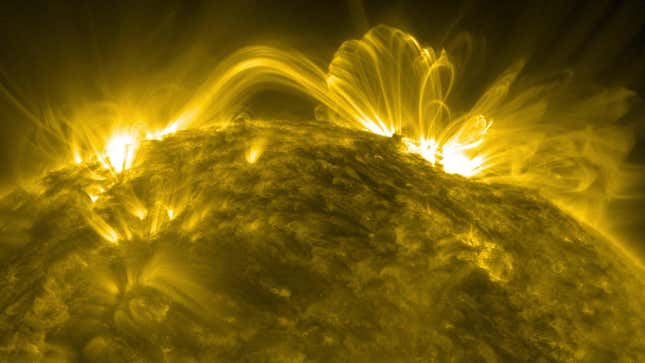
Things have been heating up for the Sun, as the star approaches peak activity during its 11-year cycle, with giant eruptions bursting regularly from its surface. Luckily for us, this coincides with the Moon passing between the Earth and its host star, offering a captivating view of the solar corona during the upcoming solar eclipse. We might also witness some extraordinary activity on the Sun during those rare moments of totality.
If you’ve been paying attention to the Sun lately, you’ve likely noticed that the massive ball of hot gas has been spewing radiation at an intense rate. The star goes through an 11-year cycle of fluctuating activity, and we are currently coming up on the solar maximum of cycle 25, which means the Sun has been exhibiting a rise in the number of sunspots, solar flares, and coronal mass ejections.
“As the Sun progresses through the cycle, it becomes very active at the maximum,” Nour Rawafi, project scientist of the Parker Solar Probe mission, told Gizmodo. “Even when you look at the structure of [the corona] itself, it’s way more complex than during the solar minimum.”
Related: Your Definitive Guide to the 2024 Great North American Solar Eclipse
During the last total solar eclipse in 2017, the Sun was nearing its solar minimum. On April 8, however, the total solar eclipse will take place as the star nears its solar maximum, which means those watching the event will have a better chance of seeing prominences, or bright, pink-hued curls or loops, coming off the Sun.
At the time of totality, the Sun’s disc is blocked by the Moon. What remains is the solar corona—the outermost layer of the Sun’s atmosphere that’s made up of plasma. “That wispy stuff around [the Sun], that’s the corona, and the shape of that changes dramatically between solar minimum and solar maximum,” Meredith MacGregor, a professor of astrophysics at Johns Hopkins University, told Gizmodo.
At the time of solar minimum, those prominent streamers and structures can only be observed at the equator of the Sun. During solar maximum, however, “anything goes,” according to MacGregor. “You see those kinds of wispy prominence structures from the poles all the way through the equator,” she added. “So there’s just a lot more structure in the corona.”
Those structures may be visible to the naked eye (while wearing protective glasses, of course), so even a casual observer of the eclipse will have the rare opportunity to view the streamers and loops. The prominences appear like streamers that are anchored to the surface of the Sun, with energy and radiation accelerated along magnetic field lines, and a solar flare is when those lines break.
“You can think of the Sun as this ball and there are magnetic field lines, and they’re all pinned to the ball someplace, but the ball is...convecting and so the lines are moving around,” MacGregor said. “And what happens is they get twisted up...which is basically the same thing as if you took a bunch of string and started tangling it up together. It gets a lot of tension in it and eventually it snaps.”
That breaking results in a burst of high energy radiation, which releases particles on the surface of the Sun, otherwise known as a coronal mass ejection. When the Sun is nearing its solar maximum, there’s an average of two to three coronal mass ejections every day. And if we are extremely lucky, there will be one during those fleeting moments of totality.
The chances of seeing a coronal mass ejection during the eclipse are slim, but they’re not zero. “You will see something like a ball moving outward at high speed,” Rawafi said. “But to be honest with you, we really don’t know what it will look like because we’ve never seen one with the naked eye.”
The past four solar cycles have been relatively calm, but solar cycle 25 is unexpectedly active. Aside from the ability to witness the Sun’s dramatic behavior from Earth, the eclipse is also an opportunity for scientists to study the Sun. “The fact that it’s during solar maximum is exciting because that means it’s very likely that there will be stronger concentrations of magnetic field at the edge of the Sun,” Kevin Reardon, a researcher at the National Solar Observatory, told Gizmodo. “We’ll be able to see some of the stronger sunspots and measure those, something we can’t really do if the eclipse was at solar minimum.”
Since the 2017 eclipse, two spacecraft have launched to study the Sun. NASA’s Parker Solar Probe and the European Space Agency and NASA’s Solar Orbiter will observe the Sun during the eclipse, providing scientists with different POVs of the star’s corona. In order to study the corona, observatories use a coronagraph, which sort of mimics an eclipse to block out the main bright disc of the star.
“The nice thing about the eclipse is that you don’t have to use technology to block out the light from the Sun,” MacGregor said. “It’s blocked out already, so everybody gets to study the Sun for free.”
More: ‘Devil Comet’ Set to Align With Total Solar Eclipse for Unique April Display